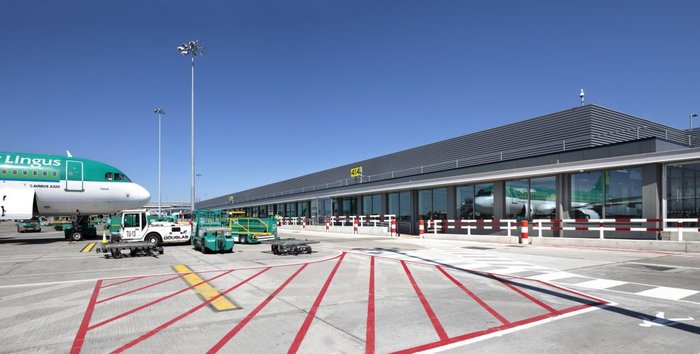Offsite construction provider The McAvoy Group has handed over a new €22m (US$25m) passenger facility at Dublin Airport, which was built offsite.
The new South Gates passenger boarding area is 120m (393ft) long and 19m (62ft) wide and will be mainly used by Aer Lingus for flights to the UK and continental Europe. It provides seven boarding gates to serve nine aircraft stands and is designed to accommodate around 8,000 passengers a day.
The 2,200m ² (23,680ft²) facility was constructed offsite at the McAvoy production center in Lisburn, Northern Ireland, to reduce time on-site. It was craned into position in 16 days as 77 steel-framed modules.
The building can also be segregated so around 1,000 departing and arriving passengers can be processed at the same time. Facilities include boarding gates, a cafe, toilets, baby changing and a workstation area with plugs and charging points.
Iain Heath, project manager at Dublin Airport, said, “This is one of the fastest projects we have ever completed at the airport – from planning to the first flight in just 18 months. The finished building speaks for itself. It is a handsome new facility with high quality finishes and clean architectural lines.
“We were working to a very constrained program to have the building operational ahead of the busy summer season. The project and its innovative use of offsite construction is a fantastic achievement for the whole team.
“We were impressed with how McAvoy used building information modeling (BIM) and virtual reality. As an airport, we have a complex approvals process, but the digital techniques allowed the senior management team to ‘walk through’ the building and to experience the facility, which facilitated design sign off.
“In addition to the program benefits, offsite construction also meant fewer trades working on-site and a smaller site footprint. This approach had far less operational impact for the airport and the closure of fewer aircraft stands with reduced timeframes,” added Heath.
Eugene Lynch, managing director of The McAvoy Group, commented, “This project successfully demonstrates the potential for offsite to improve the efficiency of airport construction, particularly in the development of airside facilities where it is so critical to minimize any impact on existing operations.
“We can reduce work on highly secure and constrained sites and rapidly install the buildings in a fast and efficient process, with no compromise on design.”
McAvoy has already been shortlisted for two industry awards for the Dublin Airport project and its innovative use of BIM and virtual reality.


